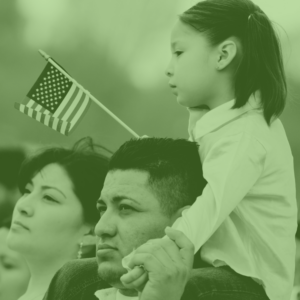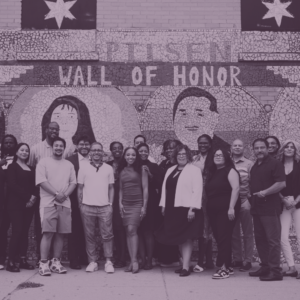The COVID-19 pandemic and efforts to restrict asylum access significantly impacted U.S. immigration policy this past year. The continuation of Title 42, a public health policy invoked by the CDC in March 2020, resulted in nearly two million expulsions at the border and a rise in family separations, detentions, and even deaths.
The political decision by Texas Governor Greg Abbott to bus migrants to sanctuary cities is the latest flashpoint in the intensifying debate at the border. States and cities continue to provide services to asylum seekers, with little support from the federal government in extending humanitarian parole or expediting work authorization.
Earlier this year, the White House announced several policies that would function as asylum bans, including a limited humanitarian parole program and a proposed “transit ban.” And, in early March, the New York Times reported that the administration had considered reinstating family detention, which has disproportionately harmed Black migrants and other migrants of color.
Lately, immigration has impacted everything, everywhere, all at once. Through my experience coordinating the Welcome to IL coalition, I have had the pleasure and opportunity to witness, listen, and reflect on the impact immigration policy has had on people and places like Chicago, a welcoming city. I recognize that I am still new in my position and that I have more to learn. I also recognize that reflection is a luxury that not too many people have in this line of work. Therefore, I hope my reflections and lessons inspire more questions and collaboration.
The transition to long-term resettlement
Six months ago, the Illinois Latino Agenda convened its first meeting of the Welcome to IL coalition. The coalition was created in response to the (now) 8,000+ asylum seekers that have come to Chicago via buses since August 2022. Now that the buses have stopped, the city and state are looking to decompress shelters and hotels and focus on long-term resettlement.¹
For example, the city reported that the Multi-Agency Resource Center (MARC) hastransitioned from crisis–response to shelter-based services. Catholic Charities now provides case management for rental assistance in the (now) seven shelters throughout the city.The City Clerk’s office provides CityKeys, which would allow migrants to ride public transit and rent an apartment. Additional support includes funding for legal services, administered by Metropolitan Family Services’ Legal Aid Society, and school enrollment by Chicago Public Schools (CPS).
Meanwhile, the Illinois Department of Human Services continues to enroll migrants in public benefits like VTTC, and the Illinois Housing Development Authority has opened the six–month rental assistance program to some families in city shelters.
Resettlement challenges
In the immigration space, resettlement can be incredibly challenging, both for those being resettled and for those designing and implementing the process. It is a complex process that takes time and requires multiple steps and key players. Local resettlementefforts can be particularly challenging to implement because communities are so diverse. Each comes with its own unique needs, capacities, strengths, and residents. Since local communities are where new immigrants end up, it is important to keep this context in mind.
Nubia Willman, Chief Engagement Officer for the city has expressed several times during the Welcome to IL meetings that finding the appropriate physical space to house new migrantshas been difficult, but finding housing in communities that are best equipped to meet their unique needshas been quite the challenge.
Take the most recent situation in the Woodlawn neighborhood on Chicago’ssouth side. In October 2022, the city identified the former Wadsworth Elementary Schoolas a suitable location to house 500-1,000 migrants.Alderwoman Taylor and Woodlawn residents originallyspoke out against sheltering migrants at Wadsworth. First, some believed it “made no sense” to bring Latino migrants into a predominantly Black community with few services for Spanish speakers. Second, Ald. Taylor said that the city had not communicated all its plans for Wadsworth to her. For years, the community has been resisting displacement and advocating for more affordable housing through the use of vacant lots and properties.
“The community made it clear that they weren’t comfortable with [the shelter] because [city officials] couldn’t answer any of their questions.” Taylor said in a phone interview with the Chicago Tribune.
It is no secret that Chicago neighborhoods are racially and economically inequitable. The city also has a housing insecurity problem. So, while it is important that immigrants are resettledand housed in a timely manner, the city must also have consideration for residents already here and the needs of that community. The same applies to areas throughout the state. We have heard from organizations downstate that migrants are resettling in their communities for a variety of reasons, such as proximity to family that already live there or potential job opportunities.
Finally, changes to federal immigration policy can impact resettlement efforts. To prepare for the end of Title 42 on May 11th, the city and state have already begun decompressingshelters and hotels to make room for new arrivals; though, the city has already begun to see an increase of migrants arriving by plane.
Just last month, the city introduced a new ‘stay policy.’ Under the policy, migrants will be given a 30-day notice to leave the shelter. Nubia explained that the policy would be rolled out in phases; in other words, those who have been in shelters the longest will be the first to receive notices.
The city committed to ongoing collaboration with housing providers to connect migrants with shelter services, regardless of how they arrived. For those who are still seeking shelter, the city is asking people to call 3–1–1 or go to the nearest police station.“It’s an imperfect process. We are going to continue to work on it to see what best practices land and how we can facilitate this better,” said Nubia.
As more migrants continue to arrive, the city is exploring ‘respite’ options, places where migrants can wait, other than police stations, until more shelter space becomes available.
Chicago as a Welcoming City
Chicago has long been a sanctuary for immigrants. But never have we had to respond to many asylum-seekers at once, with zero notice, and for months at a time. In many ways, this is unfamiliar territory, and it presents us witha new opportunity to solidify our commitment to being a welcoming city, and that involves a number of key components.
Reflecting on my time in the coalition, I have learned that a Welcoming Chicagomustinvolve clear and ongoing communication between government officials, providers, and existing residents. This includes migrants, too, whenever possible.
Next, a Welcoming Chicago must have a short- and long-term plan for welcoming and resettling new immigrants, so that when are faced with this situation again, we are more prepared and can get ahead of any challenges.
[See “The Road Forward: A Blueprint to Address New York City’s Response to the Asylum Seeker Crisis.”]
A successful plan requires commitment and accountability. The Welcome to IL coalition is committed to working with mayor-elect Brandon Johnson to address these inherited challenges head-on and continue this critical work alongside communities and leaders, to ensure a safe and welcoming environment for immigrants.This includes continued advocacy to the federal government for more funding and support.
Last, but certainly not least, a Welcoming Chicago requires compassion and empathy.Immigration is a complex issue and requires a multifaceted response. And we will not always get it right. But we must not abandon our values or allow the challenges to blind us from our goal of making Chicago a safe, prosperous, and welcoming place for all.
The Welcome to Illinois coalition will continue to meet biweekly on an as-needed basis. For questions on how to join the coalition, or any questions related to immigration, please contact Nina Sedeño, Immigration Policy Analyst, at nsedeno@latinopolicyforum.org.
___________________
¹ It has been reported that Texas is planning to resume bussing individuals and families to Chicago starting the week of May 1st, 2023. Mayor Lori Lightfoot sent a letter Sunday (April 30th) to Texas Governor Greg Abbott urging him to stop this “inhumane and dangerous action.”




